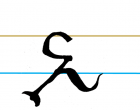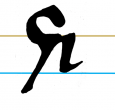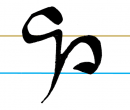z (minuscule)



A special case is the use of the letter z in the word zraif, i.e. straif, a term for a more or less comparable character in the Ogam alphabet. Damnus McManus remarks:
- Straif must originally have stood for some distinctive sound which had become /s/ by the Old Irish period, and the probability is that /st/ was sufficiently distinct from /s/ at the time to warrant being assigned a symbol of its own ... The sound /sw/, which must also have existed in Primitive Irish is another, though less likely, candidate. Both /st/ and /sw/ generally fell together with /s/ by the Old Irish period and the manuscript transcription with Z, the only remaining sibilant in Latin with which Straif could be equated, is clearly designed to effect an independent status for what was by then a redundant symbol ... Z [...] was inspired by a comparison of Ogam with the Latin and Greek alphabets.
(Damian McManus, A guide to Ogam (1991): 38.)
Cf. Paul Grosjean, ‘Notes d’hagiographie celtique, no. 14: Le sigle Z dans les manuscripts insulaires’, Analecta Bollandiana 63 (1945)


